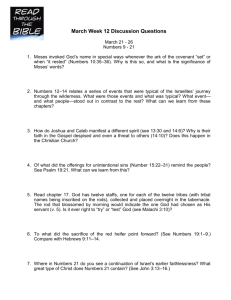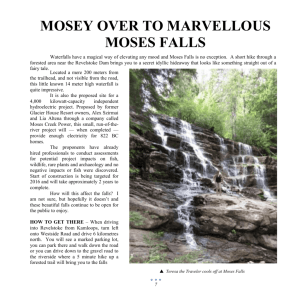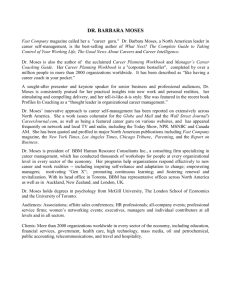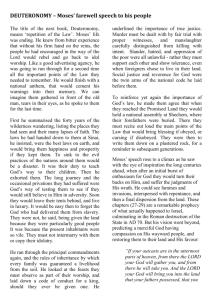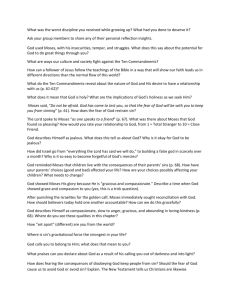MoSeS: Finding a route to a Promised Land Andy Turner
advertisement
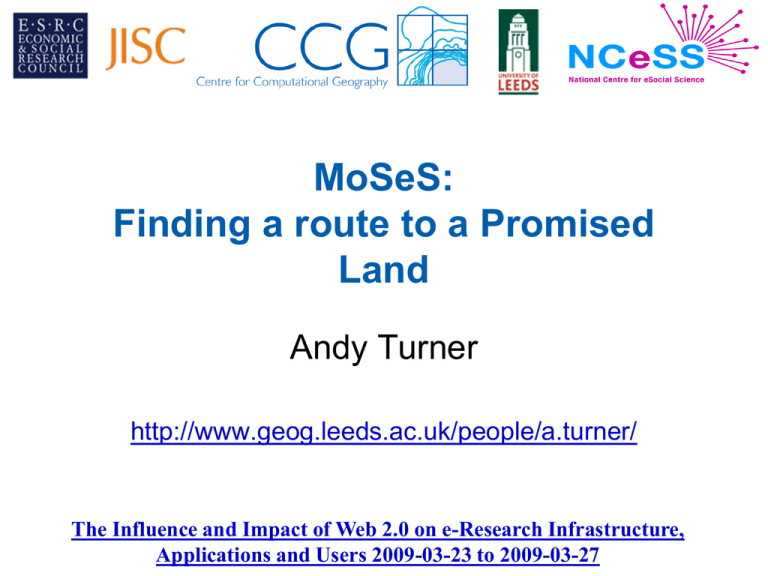
MoSeS: Finding a route to a Promised Land Andy Turner http://www.geog.leeds.ac.uk/people/a.turner/ The Influence and Impact of Web 2.0 on e-Research Infrastructure, Applications and Users 2009-03-23 to 2009-03-27 Presentation Outline • • • • • • Introduction History of my web content Web 2.0 impacts on e-Research MoSeS Sustainability GENESIS Developing an e-Infrastructure for Social Simulation (e-ISS) • Recap and the killer app Introduction • • • • This session MoSeS Micro-blogging and feedback Twitter and open micro-blogging This session • 50 minutes – Go through things at least three times • First time to introduce • Last time a brief recap • Open session – I encourage your interactive and feedback – Feedback with (micro)bloggers in the room • To demonstrate some benefits of it. MoSeS • MoSeS is about Modelling and Simulation (for of in) e-Social Science – More introduction and an attempt to define e-Social Science to follow • This presentation is more about the process of developing MoSeS and the use of blogs and wikis to capture that and bootstrap its development – I am not planning to go into detail about the demographic modelling or its applied uses unless you really want me to • • All the MoSeS code we developed is open source and Java and that is the core of our work We did use great tools developed by others to do this most of this is open source and Java – Netbeans – MPJ Express • We did use a variety of computational resources – We got more results thanks to NGS Micro-blogging and feedback • Hands up who in the room might micro-blog about research3 during this session • I’m using identi.ca @andyt – This is forwarded to Twitter @agdturner – Have a quick look • Anyone using any other service, please shout out what it is – If anyone does shout this out, someone please blog it on one of the above channels Twitter and open micro-blogging • A Twitter user for a bit over 2 days • Thanks to Twitter and its users and profile – I now appreciate the benefits of micro-blogging • But –But »But Twitter not open enough for my liking • There is an open alternative to Twitter called identi.ca – A service based on Laconica • Based on open standards • Some of you have experience with this and have used Twitter for practical reasons – I urge you to switch back – Break out before it’s too late • My friend Ciaran Gulnieks – A micro-blogging expert • Among other things • Convinced me that Laconica is a good way to go • • http://tinyurl.com/cc2yrg#ciarang I’ve been thinking about how to get this into iGoogle tomorrow and how I can then get the Google Gadget into the NCeSS Sakai Portal History of my web content • • • • • • In the beginning The dark ages and the enlightenment Blog and wiki Blog blog blog Publishing fun and metadata Using a VRE In the beginning • Web content evolves over time – I began with static web content – Served out by the CCG web server • I started to contribute project pages to this in 1997 • Soon after, the School of Geography got its own Web Server – I got a basic web home page on this – I began to develop it • Most of what I did was publish static HTML • Many projects were benefitting from using content management systems – For the lifetime of the project this was good, but for how long would the content survive? The dark ages and the enlightenment • Catastrophic end for the CCG Web Server – We had been crossing our fingers for too long • No resource to do anything about it – A major problem for CCG • • Most of the people involved on the projects hosted on that had moved on Andy Evans and I began to sort out the mess which had been accumulating since about 1994. – Our first focus was our own projects – Next were the high profile projects we were getting harassed about • We began the task of restoring the history of our research group – It has taken years to get back to where we are now • Has anyone else here experienced something like that? – Did you lose a lot? • What did you lose most of dynamic or statically served content? – RIP • Most of the CCG dynamically generated content was gone and we’re unlikely to ever get it back – Some applets survived – Pages served out via Content Managements Systems (CMS) • Backed with old databases • Fossilised • Most CCG projects had set up and used a different CMS – State of the art for the time • It seemed best to start again – Extreme • Second time round I was in charge of the web content – Determined to try to keep track of what we were doing and clean up and re-input the history as we went along. Blog and wiki • I began using wikis and blogs to collaborate in about 2005 – The initial use was for reading content – Soon I was editing wiki content and commenting on blogs as anon • It took me a while to realise that I really should get an account or to blog myself if I was ever going to keep track of my blog comments • Similarly I felt the need to start compiling a dossier of what wiki’s I used and what wiki changes I made – The tools were not really helping by recording my use and making my contribution clear • I foresaw a difficulty if I was ask for my publications and I was unable to point to any evidence that I had contributed to the development of a resource. • I wanted to make a dossier, make it open, make it a blog of sorts Blog blog blog • Start of 2006, 6 months after MoSeS began I started my own blog, blogging most working days – It was static HTML and I didn’t use any Web 2.0 tool it was all done via my area on the School of Geography web site – http://www.geog.leeds.ac.uk/people/a.turner/ • After a couple of months I produced an RSS feed and added a new item once a month. • In the first couple of months I was mainly posting about what I was reading • Soon I was blogging about much of the work I was doing • Soon I felt compelled to blog every day • Each monthly item and each daily entry took the form of nested lists • Gradually over time a daily template evolved • With practice – I got better at my style of blogging and it became less of a burden – I began blogging as I was doing things • My system/workflow involved uploaded files from a PC in my office in Leeds to the web server – I wanted to start blogging in meeting away from my office • Time to consider my options • At the start blogging was fairly time consuming thing and the rewards seemed quite distant, but I got enough reward to keep going and I got some good encouragement from others. – I might have stopped without it – My key user kept me going • Thank you Paul Townend Publishing fun and metadata • I have became increasingly aware of standards and the importance of using them to make things interoperable and improve accessibility and openness • In 2005 I started to update all my web pages so that they were conforming to the standards that had evolved • Blogging helped to drive this process, but I also had a lot of old projects and pages which I might not update often – So I systematically went though them all • Revisiting old projects and applications was interesting and good revision – It sort of kept the projects alive • None of the information content on the pages was perfect either so I began an on-going campaign of incremental improvement • I got a lot of instant satisfaction in improving these things and a feel good factor about making things available – When I got positive feedback from others or could use this work it was a great feeling • Some of my personal pages started to change quite a lot and I thought each page needed some basic metadata, a version and a date when it was published – There is a history in the comments a track of this metadata in my Web Pages • I can see when and how often I was updating things. – Occasionally I would keep a version of the page in a separate file. – As well as being useful for me to keep track, this was also potentially useful for anyone wanting to reference my web content Using a VRE • Promotion of Sakai made me give it a go • It was also open source and developed in Java and was looking to be standards compliant – It ticked these important boxes • In the last year or so, since the NCeSS Sakai Portal has been available, more and more of my blogging is being done via the wiki tool and on my personal worksite. – http://portal.ncess.ac.uk/portal/site/%7Ea.g.d.turner%40leeds.ac.uk – You’re not supposed to access that, but you can the wiki • http://tinyurl.com/c57ws2 • Which links to various resources which are mainly files • For MoSeS I wanted to capture information about meetings took place, and I started distilling Time for a progress report on MoSeS • What links to the CCG and School of Geography Web Content I’ve developed? – Who read it? • Not much chance of identifying other users now – Unless someone has been working in similar way to me – It is increasingly easy to find those links that have persisted over time and maybe one day I’ll get around to it. MoSeS Sustainability • MoSeS has matured, but how mature is it? • 8 months ago preparing for the Oxford eResearch Conference – First phase NCeSS/ESRC funding still paying it’s way – Increasing documentation burdon – Finally getting somewhere producing results and developing collaborations GENESIS • Generative e-Social Science • Deciding what to do with this • I aim to capturing the process from the start on the NCeSS Sakai Portal – Trying to encourage the team to adopt this way of working – Leaving a trail to help those trying to understand how research is done • Using a shared WordPress blog to foster collaboration and for dissemination and getting feedback on the research and research process • Progress in Agent based modelling of Daily Activity Developing an e-Infrastructure for Social Simulation (e-ISS) • JISC are the saviours of us all • We are about to start • We captured some of the process of developing the proposal • We can sustain the NCeSS Sakai Portal • Long live NCeSS! Back to origins again • SIM-UK • The next big thing • Killer app – Road Safety – Analysing road accident risk Recap and the killer app • • • • • • Introduction History of my web content Web 2.0 impacts on e-Research MoSeS Sustainability GENESIS Developing an e-Infrastructure for Social Simulation (e-ISS) • Recap and the killer app Thanks and Acknowledgements • • • • • • • • • CCG, University of Leeds SIM-UK NCeSS NGS EGEE EC/ESRC/JISC e-Research community Organisers You Introduction • Andy Turner – http://www.geog.leeds.ac.uk/people/a.turner – Autobiography – Blog • http://www.geog.leeds.ac.uk/people/a.turner/personal/blog/ • MoSeS – http://www.geog.leeds.ac.uk/people/a.turner/projects/MoSeS/ • Open e-Research – Research and blog about it in detail – Distill from the blog What is MoSeS? • Modelling and Simulation for e-Social Science – http://www.ncess.ac.uk/research/nodes/MoSeS/ – e-Social Science being the application of e-Science concepts to social science problem domains • e-Science is enhanced science that uses the Internet, software tools and structured information for collaborative work • A first phase research node of NCeSS – Part of a UK collaborative partnership developing e-Social Science – The key part of it’s program of work is to develop an individually based demographic model of the UK for 2001 to 2031 • MoSeS people MoSeS Starts for the Promised Land • Work on MoSeS was divided into 3 strands – demographic modelling – applications of demographic models – user interface and portal development • 3 applications – health care planning – transportation research – business application. My MoSeS Checklist • • • • • • Outputs to be made as openly available as possible Use appropriate standards Automate with free and open source software. Results to be replicable Be open about what we were trying to do and how Adopt best practice and learn from others in NCeSS and think about what else they wanted. Blogging • • • • • • What is a blog? Why blog? The evolution of my blog People use my blog It has opened up what I do The benefits far outweigh the costs Philosophy of e-Social Science • Jankowski 2007, Scott and Venters 2007 • Is e-Social Science open by definition? • Is e-Social Science more than simply the application of e-Science methods to the social sciences? Reflection on MoSeS • Never-ending story… • Too early to judge? • There are many positives: – I have learned a great deal over the last 3 going on 4 years and found a community of collaborators that I am happy and excited to work with. – I have developed a lot of structured information about me and my research interests. – I have participated in lots of surveys. Acknowledgements and Thanks • This work was supported by the ESRC under RES-149-25-0034. • Thanks to all involved in eResearch for your ongoing collaboration. • Special thanks to my NCeSS and MoSeS colleagues. • Thanks to the Oxford eResearch conference organisers. • Thank you for listening! MoSeS Rationale • The idea is to provide planners, policy makers and the public with a tool to help them analyse the potential impacts and the likely effect of planning and policy changes. • Example Application: – There may be a housing policy to do with joint ownership, taxation and planning restriction legislation that can be developed to alleviate problems to do with lack of affordable housing and workers without precipitating a crash in the housing market and economy as a whole – A balanced policy may be easier to develop by running a large number of simulations within a system like SimCity for real to understand the sensitivities involved Initial Tasks • Develop methods to generate individual human population data for the UK from 2001 UK human population census data • Develop a Toy Model – Dynamic agent based microsimulation modelling toolkit and apply it to simulate change in the UK • Develop applications for – Health – Business – Transport Challenges • Grid enabling the data and tools • Visualisation – Google Earth – Computer Games • Collaboration • Retaining a problem focus • Design and Development Generic MoSeS Approach • MoSeS to date has approached Modelling and Simulation from a specific angle – – – – – Geographic Demographic Contemporary About the UK Targeted towards supporting a developing set of applications • It is not a requirement to make it clear what steps can be followed by other Social Scientists wanting to Model and Simulate something different – However, the generic work of MoSeS should be relevant and we are working towards this MoSeS Vision • Suppose that computational power and data storage were not an issue what would you build? – SimCity • http://en.wikipedia. org/wiki/SimCity • For real on a national scale MoSeS First Steps • The development of a national demographic model • The development of 3 applications – Health care – Transport – Business • The development of a portal interface to support the development and resulting applications by providing access to the data, models and simulations and presenting information to users (application developers) in a secure way Households Communal Establishments Aggregate HPControl Characteristics HSAR ISAR Aggregate CEP Control Characteristics
